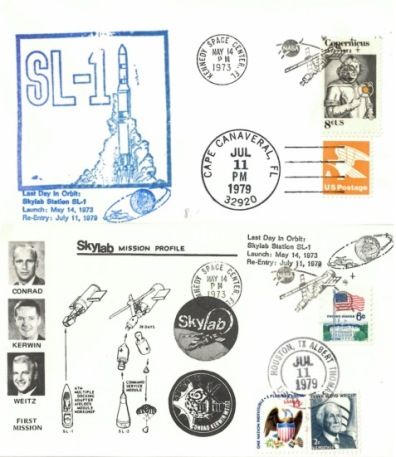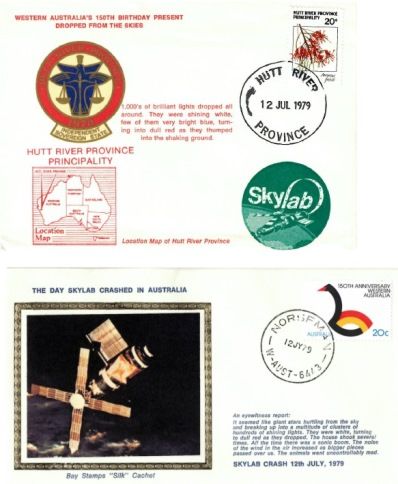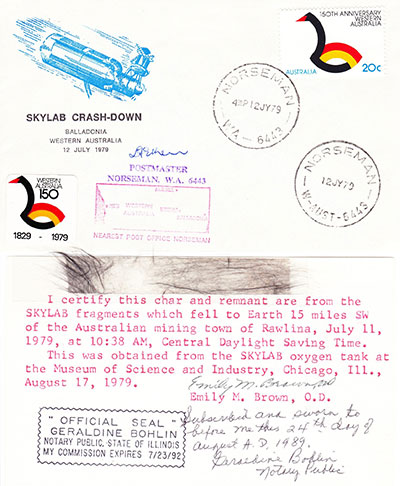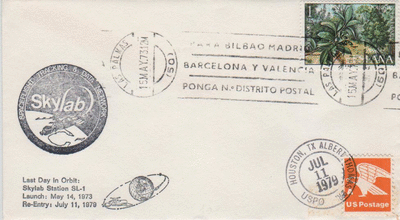Space Cover 373: Skylab Workshop Re-entrySkylab was a NASA space station orbiting Earth from May 1973 to July 1979, and included a workshop, a solar observatory, and other systems. It was the first United States space station as the DOD Manned Orbital Lab (MOL) space station program had been cancelled. The Skylab station was launched unmanned by a modified Saturn V rocket, with a weight of 170,000 pounds on May 14, 1973. Three manned flights to the station were conducted between May 25, 1973 and February 8, 1974 using the Apollo Command/Service Module (CSM) atop the smaller Saturn IB. There were three three-astronaut crews – Pete Conrad, Joe Kerwin, Paul Weitz; Alan Bean, Owen Garriott, Jack Lousma; and Jerry Carr, Ed Gibson, Bill Pogue . On the last two manned missions, an additional Apollo / Saturn IB stood by ready to rescue the crew in orbit if it was needed with a rescue crew of Vance Brand and Don Lind.
The station was damaged during launch when the micrometeoroid shield separated from the workshop and tore away, taking one of two main solar panel arrays with it and jamming the other one so that it could not deploy. This deprived Skylab of most of its electrical power, and also removed protection from intense solar heating, threatening to make it unusable. The first crew was able to save it in the first in-space major repair, by deploying a replacement heat shade and freeing the jammed solar panels.
The Skylab station included the Apollo Telescope Mount - a multi-spectral solar observatory, Multiple Docking Adapter with two docking ports, Airlock Module with EVA hatches, and the Orbital Workshop, the main habitable location. Electrical power came from solar arrays, as well as fuel cells in the docked Apollo CSM. The rear of the station included a large waste tank, propellant tanks for maneuvering jets, and a heat radiator.
Numerous scientific experiments were conducted aboard Skylab during its operational life. The Earth Resources Experiment Package (EREP) was used to view Earth with sensors that recorded data in the visible, infrared, and microwave spectral regions. Thousands of photographs of Earth were taken, and the record for human time spent in orbit was extended beyond the 23 days set by the Soyuz 11 crew aboard Salyut 1, to as much as 84 days by the Skylab 4 crew. Plans were made to refurbish and reuse Skylab, using the Space Shuttle to boost its orbit and repair it. However, development of the Shuttle was delayed, and Skylab reentered Earth's atmosphere and disintegrated on July 11, 1979 (US; July 12 Western Australia), with debris striking portions of Western Australia.
Depicted in the scan above are two covers for the re-entry of Skylab over Western Australia on July 12, 1979. Both covers refer to the 1000s of brilliant lights as the station reentered the atmosphere. The eyewitness report printed on one of the covers states:
"It seemed like giant stars hurtling from the sky and breaking up into a multitude of clusters of hundreds of shining lights. They were white, turning to dull red as they dropped. The house shook several times. All the time there was a sonic boom. The noise of the wind in the air increased as bigger pieces passed over us. The animals went uncontrollably mad."

Covers exist for the orbital launch and for all the days the Skylab station was manned.
In addition, a number of collectors created Skylab "lifetime covers" by taking Skylab station launch covers and adding an additional postmark at KSC, Cape Canaveral or Houston for the re-entry as shown above.
















